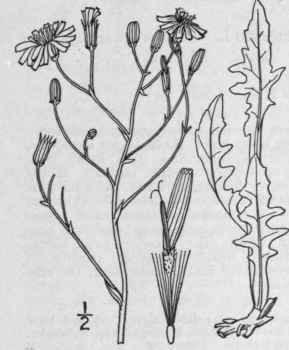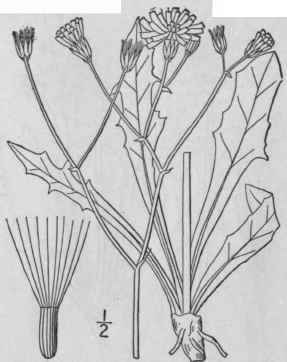21. Crepis L. Sp. Pl. 805. 1753
Description
This section is from the book "An Illustrated Flora Of The Northern United States, Canada And The British Possessions Vol3", by Nathaniel Lord Britton, Addison Brown. Also available from Amazon: An Illustrated Flora of the Northern United States, Canada and the British Possessions. 3 Volume Set..
21. Crepis L. Sp. Pl. 805. 1753
Perennial, biennial or annual herbs, with alternate or basal, mostly toothed or pinnatifid leaves, and small or middle-sized heads, usually paniculate or corymbose, of yellow or orange flowers. Involucre cylindric, campanulate, or swollen at the base, its principal bracts in 1 series, equal, with a number of exterior smaller ones. Receptacle mostly flat, naked or short-fimbrillate. Rays truncate and 5-toothed at the apex. Anthers sagittate at the base. Style-branches slender. Achenes linear-oblong, 10-20-ribbed or nerved, not transversely rugose, narrowed at the base and apex, beakless in our species. Pappus copious, of very slender white bristles. [Greek, sandal; application not explained.]
About 200 species, natives of the northern hemisphere. Besides the following, about 20 others occur in western North America. Type species: Crepis tectorum L.
Involucre glabrous.
Involucre cylindric; plant pubescent below; introduced.
1. C. pulchra.
Involucre campanulate; plant glaucous; native, western.
2. C. glauca.
Involucre pubescent, glandular, or canescent.
Foliage not canescent nor scurfy, sometimes hirsute.
Stems naked, or with 1 or 2 small leaves; western, native.
3. C. runcinata.
Stems leafy; introduced annuals or biennials.
Stem leaves narrow, revolute-margined. sessile.
4. C. tectorum.
Stem leaves lanceolate, clasping, not revolute-margined. Involucre 3"-4" high; achenes 10-striate.
5. C. capillar is.
Involucre 4 -6 high; achenes 13-striate.
6. C. biennis.
Foliage cinereous, canescent, or scurfy, sometimes also hirsute. Inner bracts of the involucre 5-8; flowers 5-8.
7. C. intermedia.
Inner bracts of the involucre 9-24; flowers 10-30.
8. C. occidentahs.

1. Crepis Pulchra L. Small-Flowered Hawks-Beard
Fig. 4086
Crepis pulchra L. Sp. Pl. 806. 1753.
Annual; stem 2°-4i° high, leafy and pubescent below, mostly glabrous, naked, and paniculately branched above. Stem leaves oblong or oblong-lanceolate, dentate, clasping by an auricled base or truncate, pubescent, 3'-4' long, acute or obtuse, or the uppermost lanceolate, acuminate and entire; basal leaves runcinate, narrowed into petioles; heads very numerous, about 3" broad, in a large naked panicle; involucre narrow, cylindric, glabrous, about 5" high, its principal bracts 12-15, linear, acuminate, the outer ones very short, ovate, appressed; achenes linear, faintly 10-nerved, slightly narrowed above.
Along railroad near Culpepper, Virginia, very abundant in 1890. Naturalized or adventive from Continental Europe. May-July.

2. Crepis Glauca (Nutt.) T. & G. Glaucous Hawksbeard
Fig. 4087
Crepidium glaucum Nutt. Trans. Am. Phil. Soc. (II.) 7:436. 1841.
Crepis glauca T. & G. Fl. N. A. 2: 488. 1843.
Perennial; scapose, or rarely with 1 or 2 leaves on the stem, 1°-21/2° high, glabrous and glaucous throughout. Basal leaves spatulate, oblanceolate, or obovate, acute or obtuse at the apex, gradually narrowed into margined petioles, entire, dentate, or pinnatifid, 2'-6' long, 1/2'-1' wide; heads not numerous, long-peduncled, 6"-12" broad; peduncles glabrous; involucre campanulate, its principal bracts lanceolate, acute, the outer ones very short, ovate, appressed; achenes oblong-cylindric, slightly narrowed above, strongly 10-ribbed.
In moist and saline soil, Nebraska to Saskatchewan, Utah and Nevada. July-Aug.
Continue to:


